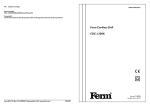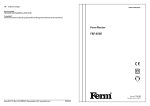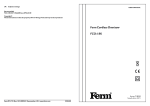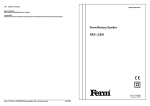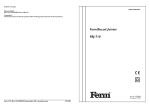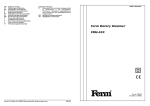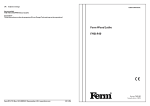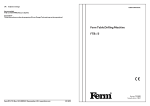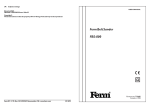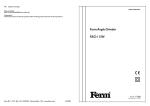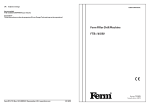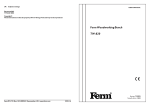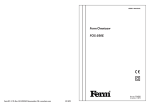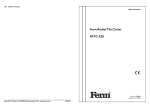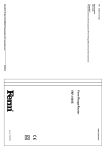Download Ferm Cordless Drill FDC
Transcript
UK Subject to change USER’S MANUAL Document Ref: FDC-1800K/00000/AAA00/issue 0/Month 00 Copyright © These instructions are the sole property of Ferm-Omega Tools and may not be reproduced Ferm Cordless Drill FDC-1800K Art.nr. 718380 Screwfix Art.nr. 18424 Ferm BV • P.O. Box 134 • 8280 AC Genemuiden • NL • www.ferm.com 0304-11 EXPLODED VIEW 2 3 6 4 1 5 Fig. A Fig. E Fig. B Fig. F Fig. C SPARE PARTS LIST FDC-1800K REF NR 003 004 010 011 034 038 - Fig. D 2 Ferm Ferm DESCRIPTION SWITCH BATTERY KEYLESS CHUCK 0.8 - 10 MM BOLT LEFT FOR CHUCK MOTOR LEFT/RIGHT BUTTON CHARGER FERM NR 406654 318381 406470 406403 406653 406656 406655 11 SAFETY INSTRUCTIONS The following pictograms appear throughout these operating instructions: CORDLESS DRILL THE NUMBERS IN THE FOLLOWING TEXT CORRESPOND WITH THE PICTURES AT PAGE 2 Indicates danger of injury, risk to life and possible damage to the appliance if these instructions are not followed. Indicates the presence of electrical current. TECHNICAL DATA Voltage Charger voltage Charger frequency Battery output Charging time Drill speeds Max. torque (low speed) No-load speed Chuck capacity Weight (incl. battery) Lpa (sound pressure) Vibration — | 18 V--| 230 V | 50 Hz | 1.3 Ah | 1 hour |2 | 20 Nm | 0-400/0-1150 rpm | 0.8 - 10 mm | 1.8 kg | < 70 dB(A) | < 2.5 m/s2 PRODUCT INFORMATION Fig. A 1 On/off switch 2 Speed selector switch 3 Torque setting ring 4 Chuck 5 Battery 6 Direction switch CONTENTS OF CARRYING CASE The carrying case contains: 1 Cordless drill 1 FDC-1800B battery 1 FDC-1800L battery charger 1 Operating instructions 1 Safety instructions 1 Warranty card Check the appliance, any loose parts and accessories for damage caused during transport. Read through these operating instructions carefully before using the appliance. Become familiar with the functions and method of operation. To ensure proper operation, always maintain the appliance according to the instructions. The operating instructions and associated documents should always be kept close to the appliance. Ferm products are manufactured to high quality standards they are safe and fit for purpose at time of sale, but all tools can be dangerous if the correct precautions are not taken. Always follow these instructions, do not carry out the operation until you are sure you can do so in safety. Remember to consider the work environment for safe operation as well as safety for tool use. Warning! When using electric tools, basic safety precautions should always be followed to reduce the risk of fire, electric shock and personal injury. Read all these instructions before attempting to operate this product. Save these instructions for future reference. PERSONAL SAFETY Use Personal Protection Safety Equipment Protect eyes with safety glasses or goggles note: the use of safety protective eyewear without the CE mark can lead to serious injury if the lens breaks. A suitable dust mask should be worn if cutting; drilling or sanding is dusty, in particular chipboard or MDF. Approved safety footwear and headgear should worn as appropriate, for example on building works or when heavy weights are involved. Wear a suitable apron to protect against sparks/debris. Wear earplugs or ear defenders. Dress properly Do not wear loose clothing or jewellery. It can get caught in moving parts. Non-skid footwear is recommended when working out doors. Wear protective hair covering to contain long hair Stay alert Watch what you are doing Use common sense. Do not operate tools when tired or after taking alcohol or prescription/ non-prescription drugs. 10 Ferm Ferm 3 OPERATIONAL SAFETY Warning! The battery is normally sealed but in event of the battery being damaged be aware that it contains acid, if you get any on your skin or in your eyes wash the affected parts with water immediately and seek medical advice as soon as possible. Warning! Do not short circuit the battery it will cause it to overheat, catch fire or even explode. To avoid this happening: Do not connect wires to the terminals of the battery. Do not expose the battery or drill to water, rain or damp atmospheres. Ensure that no metal objects (coins, nails etc) are caught in the battery housing or battery socket in the drill. Do not throw or dispose of the battery into water or fire. Concentrate Routine and repetition can lead to mistakes. Remember that a slight lack of concentration can result in serious injuries in a split second. Keep work area clean Cluttered areas and benches invite injuries. Consider the work environment Do not expose power tools to rain or use them in damp or wet locations. Keep work area well lit. Do not use power tools in the presence of flammable liquids, vapours or gases. Guard against electric shock This unit and its charger contain dangerous voltages. Use a RCD (residual current device) to provide protection against electrical shock. Prevent body contact with grounded surfaces (e.g. pipes, radiator, ranges or refrigerators). Keep children and pets away Do not let children or pets come into contact with the tool, extension cable or work area. Do not force the tool It will work better and safer at the rate for which it was intended. Use the right tool Do not force small tools or attachments to do the job of a heavy-duty tool. Do not use tools for purposes for which they were not intended; for example do not use a circular saw for cutting trees or logs. Do not over-reach Keep a proper footing and balance at all times. Disconnect tools from power supply When not in use, before servicing and when changing accessories such as blades, bits and cutters. Always remove the battery and set the direction switch to lock position. Always switch off and unplug from the power supply before making adjustments or inserting batteries into charger unit. Remove adjusting keys and wrenches Ensure that they are removed from the tool before switching on. Avoid unintentional starting Do not carry plugged in tools with your finger on the switch. Check that the switch is off before plugging in to socket. Extension cables Use only three core earthed extension cables suitable for the power input of the tool (minimum cable size 1.5mm2). Plug into an earthed socket only. When using a cable reel unwind it fully. Do not use long extension cables. Outdoors use If the tool is suitable to be used outdoors, only use an extension cable intended for outdoor use and marked accordingly. Use a RCD (residual current device) to provide protection against electrical shock. Do not use in rain or damp conditions. Connect a dust extraction device Whenever there are facilities for fitting a dust or fume extraction system, make sure it is connected and used. Use recommended accessories The use of any other accessory or attachment other than recommended in the instructions or catalogue may present a risk of personal injury. Warning! Before using this drill check carefully for hazards, for example when drilling walls make sure you do not contact with electrical wires, water pipes or asbestos. If asbestos is present, cease operations and contact your local council for advice. Do not abuse cable Never carry the tool by the cable or pull it to disconnect it from the power socket. Keep the cable away from heat, oil and sharp edges. Do not touch the metal plug pins when connecting or removing the plug. Secure Work Use clamps or a vice to hold work. It is safer than using your hand and it frees both hands to operate the tool 4 Ferm Ferm 9 MOUNTING ACCESSORIES OPERATION Fig. B Fig. D Always remove the battery before starting work. FITTING AND REMOVING DRILL CUTTERS In addition to drill cutters, the tool can also accommodate screwdriver bits with a hexagonal shaft. • Loosen the drill chuck (4) by rotating the hand-grip (9). • Insert the shaft of the drill cutter into the chuck. • Tighten the drill chuck so that the drill cutter is firmly clamped. • Rotate the drill chuck in the opposite direction when you wish to change the cutter. CONNECTING AND REMOVING THE BATTERY Fig. C Ensure that the exterior of the battery block or tool is clean and dry before connecting the charger. • • • Ensure that the direction reversing switch (6 Fig. A) is in the central position in order to prevent the appliance from being switched on unexpectedly. Insert the battery (5) into the base of the appliance, as shown on the illustration. Push the battery until it latches in. Press the locking buttons (10) on both sides before removing the battery, and disengage the battery from the base of the appliance. Always follow the safety notes and the relevant safety code. Hold the appliance firmly and press the drill cutter steadily onto the workpiece. Do not overload the appliance. Only use drill cutters with no visible wear. Worn drill cutters will have a bad effect on the functioning of the appliance. ADJUSTING THE SPEED The appliance has two drill speeds. • For slow drilling or for driving or removing screws, set the speed selection switch (2) to '1'. • For fast drilling set the speed selection switch to '2'. NEVER SWITCH OVER WHEN THE MOTOR IS RUNNING!!! ADJUSTING THE TORQUE Fig. E The appliance has 16 different torque settings with which to set the power for driving and removing screws. • Set the torque adjustment ring (3) to the desired position. The available torque settings are indicated on the adjustment ring by the numbers 1 to 8 and by dots between the figures to define intermediate settings (16 in total). • You should preferably choose as low a setting as possible when using the screwdriver. Select a higher setting if the motor slips. DRIVING AND REMOVING SCREWS • Set the direction reversing switch (6) to position 'R' in order to drive screws. • Set the direction reversing switch to position 'L' in order to remove screws. DRILLING • Rotate the torque adjustment ring (3) to the drilling position. Ensure that the direction reversing switch (6) is always set to 'R' during drilling. SWITCHING THE DEVICE ON AND OFF Fig. A • Depress the on/off switch (1). It regulates the speed of the appliance by transmitting power to the switch. • Release the on/off switch (1) to halt the drill chuck immediately which will no longer run on. • Move the direction reversing switch (6) to the centre in order to lock the appliance in its disabled state. Only lay down the appliance when it has stopped running completely. Do not place it on a dusty surface as particles of dust could get into the mechanism. 8 Ferm Ferm 5 CHARGING THE BATTERY Fig. F The FDC-1800L battery charger is only suitable for charging batteries of type FDC-1800B. • Place the battery (5) inside the charger (11), as shown on the illustration. Pay attention to + and - pole markings. • Insert the charger plug into a power socket. The red rapid charging lamp (12) should now be illuminated. • As soon as the green trickle charging lamp (13) lights up, charging has been completed and the device is ready for operation. Only use the charger in a dry environment at temperatures between 10˚C and 40˚C. The battery in your drill was not charged up at the factory. Before using it for the first time, you should charge it for approx. 1 – 2 hours so that it reaches full capacity. The final capacity of the battery is reached after 4 – 5 battery cycles. DISCHARGING THE BATTERY Not only charging batteries is important, discharging is of equal importance or even greater importance. • • • • When the battery is charged the cordless drill has to be used until you start noticing that the power of the drill is diminishing and that the maximum rotational speed is not reached. The battery is almost discharged now. Only now you can start charging the battery. Charging the battery while it is still charged for say one-third of capacity, the so-called ‘memory effect’ can occur. Since during charging only the discharged part of the battery capacity of the battery is being charged now, the battery can start crystallizing in the one-third that is still charged. This part of the battery capacity can never be used afterwards. Do not discharge the battery to the minimum. As soon as you notice that the power or the maximum rotational speed is diminishing, you have to charge the battery. When you proceed using the drill and the battery becomes fully discharged, the so-called ‘switch of poles effect’ can occur. The polarity of the battery poles will be switched: the ‘+’will become ‘-‘ and the ‘-‘ will become the ‘+’. Once this has occurred the polarity will remain switched during loading and this will damage the battery irreparable. When the cordless drill is not being used over a longer period of time, the battery has to be charged fully first. The battery has to be stored in charged condition. MAINTENCE, CARE AND REPAIR CLEANING Clean by brushing with a soft brush Do not use flammable liquids to clean the drill – never use solvents such as petrol, ammonia or alcohol; they damage the plastic parts and present a fire risk. FAULTS Switch OFF immediately at the mains plug and remove the plug when: • The plug or cable is damaged. • The charger is not operating as it should. • You smell or see smoke caused by scorched insulation in the machine or charger. ELECTRICAL INFORMATION This product is complete with a pre-wired mains plug, it is double insulated in accordance with EN 60335 – no earth wire is required If the plug needs replacing follow these instructions. Wire correctly The wires in the mains lead are coloured in the following way: BLUE • Neutral BROWN • Live Green & Yellow (Earth) Overheating The ventilation slots are blocked with dirt. Clean with dry cloth. Blue (Neutral) Fuse (5 Amp) Brown (Live) The machine does not start when switched on • Change the battery for a fully charged one. • Check that the battery charger is working, if the charging light does not come on; change the fuse in the plug. • Take to your Ferm Dealer for repair. Securing wires Secure wires carefully and firmly to the correct terminals. Secure the mains cable in the plug cord grip firmly Fit a 5-amp fuse. If a 13amp (BS1363) plug is used a (BS 1362) ASTA approved 5-amp fuse must be fitted. The motor is defective Take to your Ferm Dealer. Recycle/Dispose of old plug and cable Prevent inadvertent connection to socket and risk of electric shock. If in doubt always consult a Qualified Electrician. MAINTAIN TOOLS WITH CARE Keep the tool clean for better and safer performance. Store the accessories properly in accordance with the maker’s instructions. Follow instructions for changing accessories. Inspect tool and extension cables periodically and if damaged, have them repaired by a qualified person or authorised service body. Keep handles free from oil or grease. Keep the ventilation slots clean to prevent motor overheating. Check for damaged parts Do not use a tool with damaged parts, before further use a damaged tool must be carefully checked by a qualified person to determine that it will operate properly. Check for alignment of moving parts, binding or breakage of parts, mounting and other conditions that may affect its operation. A damaged part or guard should be properly repaired by an authorised service centre, unless indicated otherwise in the instruction manual. Have defective switches replaced by an authorised service centre. Do not use a tool if the switch does not turn on and off. GUARANTEE The guarantee conditions can be found on the separately enclosed guarantee card. CEı DECLARATION OF CONFORMITY (UK) We take sole responsibility for confirming that this product conforms with the following standards or related documents: EN50260-1, EN50260-2-1, EN50260-2-2, EN55014-1, EN55014-2, EN60335-1,EN60335-2-29, EN61000-3-2, EN61000-3-3 iin compliance with the provisions of the Directives: 98/37EEC, 73/23/EEC, 89/336EEC from 01-12-2002 GENEMUIDEN NL W. Kamphof Quality department ENVIRONMENT Recycle the packaging according to the identification marks on it. At the end of the product or its accessories life please recycle where facilities exist. NiCd batteries are recyclable, take them to a local recycling station or phone the Helpline for current advice on recycling. HELPLINE For any questions relating to operational or safety matters contact: Ferm Customer Helpline on: 0115 966 1199 Monday-Friday 8am – 6pm Saturday 9am – 1 pm Have your tool repaired by an expert This appliance is manufactured in accordance with relevant safety standards. Only experts must carry out repairing of electrical appliances, otherwise considerable danger for the user may result. Storing tools When not in use tools should be stored in the dry, out of reach of children. 6 Ferm Ferm 7






